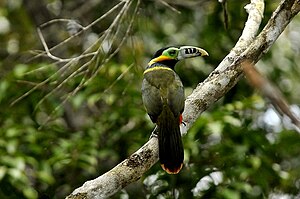Spotted arassari
| Spotted arassari | ||||||||||
|---|---|---|---|---|---|---|---|---|---|---|

Spotted arassari, male |
||||||||||
| Systematics | ||||||||||
|
||||||||||
| Scientific name | ||||||||||
| Selenidera maculirostris | ||||||||||
| ( Lichtenstein , 1823) |
The spotted arassari ( Selenidera maculirostris ), also called golden-eared arassari , is a species of bird in the toucan family. Spotted arassaris are one of the few species of toucan that has a conspicuous sexual dimorphism . The species occurs in South America. The IUCN classifies them as ![]() (= least concern - not endangered). No subspecies are distinguished.
(= least concern - not endangered). No subspecies are distinguished.
Appearance
The Fleckenarassari reaches a body length of 32 to 34 centimeters. Adult males have a wing length of 12.7 to 13.6 centimeters. The tail measures 10.3 to 11.6 inches and the beak length is 4.9 to 6.2 inches. Females have similar body dimensions, but have a slightly shorter beak at 4.6 to 5.5 centimeters.
The spotted arassari is very similar to the closely related Gould arassari . In the males of the Fleckenarassaris the head, neck, throat and chest have shiny black plumage. There is a narrow, yellow band in the neck. Another yellow stripe runs from below the featherless eye region to the ear region. The back, the rump, the tail and the upper side of the wing are olive green. The six central tail feathers have brown tips. The upper tail coverts are dark green, the under tail coverts red. The flanks are golden orange, the legs brown. The belly is yellow-green.
The beak is small for a species of toucan in relation to its body size. It is whitish-horn-colored with a green-yellow tip and black cross bars. These are particularly pronounced on the upper beak. The featherless eye area is light blue, the iris yellow. Feet and legs are green-blue. Females are very different from males. With them, both the yellow ear stripe and the neck band are less intense yellow. In some females, the neck band is even completely absent. The head, neck, throat and chest are dark brown with them, the chest has a reddish tinge and the top of the head and the neck are dark chocolate brown. The beak usually has a less noticeable black markings than that of the males.
In its area of distribution, the spotted arassari is the smallest toucan species. Due to the dull plumage, it is less noticeable than other toucans. Often, however, his calls can be heard. Regularly repeated deep, guttural croaks, which are onomatopoeically described as growwa or ehho are characteristic.
Distribution area and habitat
While the distribution areas of other short-billed macaroni species are adjacent to one another, the spotted macaroni is isolated from them in southeastern Brazil. Its distribution area extends from the east of Minas Gerais and the south of Bahia to Paraná and Santa Catarina . Originally, it also occurred in the northeast of the southernmost Brazilian state of Rio Grande do Sul . The east and central area of Paraguay and the extreme northeast of Argentina also belong to its range . The altitude distribution ranges from sea level to altitudes of 1200 meters.
The habitat of the Fleckenarassaris are moist, subtropical forests, as well as secondary forests bordering on untouched forests and forests with selective logging. Along forested rivers it penetrates into the Cerrado . Occasionally it can also be observed in fruit-bearing trees that are isolated at a short distance from the edge of the forest.
Way of life
The spotted arassari mainly eats fruit. Birds kept in captivity are known to catch insects and feed dead young mice to their nestlings. They mostly look for food individually, are occasionally observed in pairs, but only relatively rarely in small family groups.
Reproductive biology has so far been little studied. Spotted arassaris are cave breeders that mainly use old, abandoned woodpecker holes as nesting sites. The clutch consists of two to three elliptical, white eggs. The breeding season varies depending on the geographical latitude; in the Sao Paula to Bahia region it falls in the period from October to January. The incubation period is estimated at fifteen days. During the night both parent birds stay in the brood cave. Both parent birds feed, but there are no observations as to what nestlings of the Spotted Macaroni are fed with in the wild or what part of the care of the young birds the male and female parent birds have.
Nestlings develop slowly, from about the 25th day of life their sex can be determined based on the plumage. Spotted macaws raised in captivity weighed an average of 120 grams on the 31st day of life and ate up to 40 grams per day. Up to the 50th day of life they were dependent on feeding by the parent birds. From about the 62nd day of life, the beak began to show the color of adult birds and the feathered eye area turned bluish.
supporting documents
literature
- Werner Lantermann: Toucans and Arassaris. Filander Verlag, Fürth 2002, ISBN 3-930831-46-5
- Lester L. Short and Jennifer FM Horne: Toucans, Barbets and Honeyguides - Ramphastidae, Capitonidae and Indicatoridae . Oxford University Press, Oxford 2001, ISBN 0-19-854666-1
Single receipts
- ↑ Avibase on Fleckenarassari , accessed on January 9, 2011
- ↑ Lantermann, p. 147
- ↑ Short et al., P. 353
- ↑ Short et al .., p. 352
- ↑ Lantermann, p. 148
- ↑ Short et al., P. 353
- ↑ Short et al., P. 354
- ↑ Short et al., P. 355
Web links
- Selenidera maculirostris in the Red List of Threatened Species of the IUCN 2013.1. Listed by: BirdLife International, 2012. Retrieved October 23, 2013.

